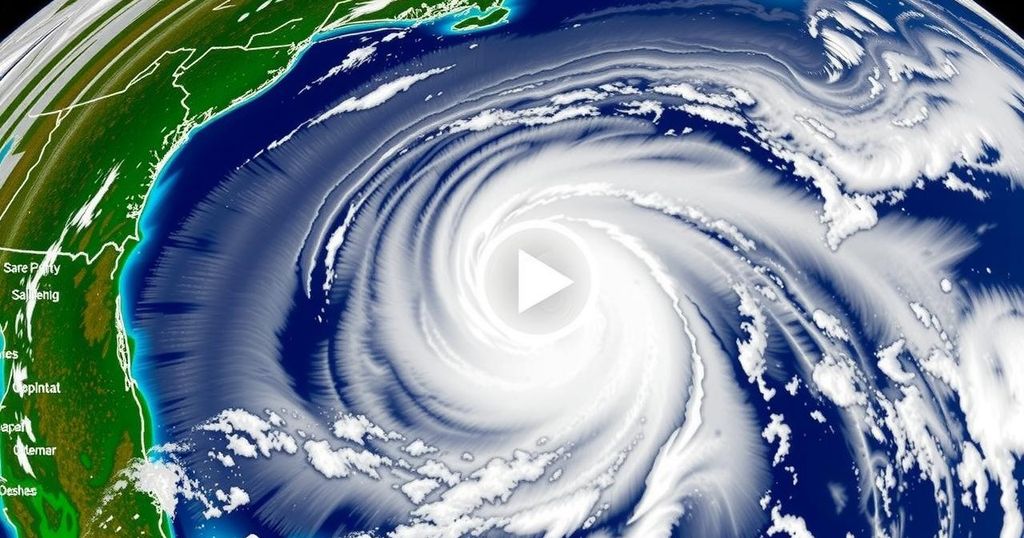Declining Prospects for Storm Nadine as Hurricane Season Progresses

Storm Nadine, initially projected to threaten Florida, has seen a sharp decline in its likelihood of development. According to the National Hurricane Center, the chance of transformation into a tropical storm has reduced to 30%. The system currently exhibits wind speeds below the threshold needed for naming and is expected to impact Caribbean regions without likely becoming a hurricane. Continued monitoring is essential as the hurricane season progresses into November.
Storm Nadine, also referred to as Invest A94L, which had garnered significant public attention due to its initial forecast of potential development into a hurricane threatening Florida, is exhibiting diminishing prospects for advancement. The storm has been developing in the Atlantic for over a week; on Tuesday, the National Hurricane Center (NHC) had indicated a 60% chance of it becoming a tropical storm. However, more recent updates revealed that this likelihood has lowered to 30% over the upcoming week. Currently, the system lacks the required wind speed of 39 miles per hour to be officially designated as Nadine, as it is presently traveling at only 20 miles per hour. Nonetheless, the NHC’s report could be seen as good news for Caribbean islands previously in the storm’s anticipated path, helping avert potentially devastating impacts. Meteorologists are monitoring this tropical disturbance closely, as prior systems Helene and Milton have already posed significant threats to the United States. The NHC noted that while some slow development of the storm is possible in the next couple of days, strong upper-level winds are likely to inhibit further growth by the weekend. The storm is currently projected to pass near the Virgin Islands and Puerto Rico on Friday, subsequently approaching Hispaniola and the southeast Bahamas on Saturday. AccuWeather has raised concerns regarding potential life-threatening mudslides and power outages, particularly in the Dominican Republic, while rainfall estimates could reach up to 20 inches in northern Hispaniola, coupled with wind gusts of 90 miles per hour. Lead Hurricane Expert at AccuWeather, Alex DaSilva, mentioned that they had been tracking a tropical wave from Africa that could become a tropical storm as it approaches the northeastern Caribbean. Despite some signs of organization, experts suggest that the development of Nadine remains unlikely, as corroborated by atmospheric science specialists at the University at Albany. They explained that the low chances of formation are due to multiple factors, including observations of wind and cloud patterns. Currently, discussions around the Atlantic hurricane season, which lasts until November 30, emphasize that there still exists the potential for additional storm formation despite the waning prospects of storm AL94. It is essential to remain vigilant as the season progresses, particularly in light of recent storms that have caused extensive damage and loss of life, such as Hurricane Milton, which previously impacted Florida in early October.
Hurricane season in the Atlantic, which persists until November 30, often sees numerous weather disturbances that can develop into dangerous storms. The recent attention on storm Nadine (Invest A94L) has stemmed from its potential to disrupt lives and property, especially as areas like Florida remain in recovery from recent hurricane events. The National Hurricane Center plays a critical role in monitoring these systems, issuing updates and alerts based on evolving weather patterns among the Caribbean and Atlantic regions. This season has already witnessed severe hurricanes, illustrating the unpredictable and potentially destructive nature of tropical storms.
In summary, while storm Nadine initially appeared to threaten further coastal disruptions, the latest updates indicate a significant decline in its potential to develop into a named storm. As meteorologists continue to monitor this system and its impacts on surrounding regions, particularly the Caribbean, it remains crucial for residents in affected areas to stay informed and prepared. The Atlantic hurricane season is far from over, with continued prospects for new storm developments in the coming weeks, necessitating ongoing vigilance from both meteorological experts and local communities.
Original Source: www.dailymail.co.uk







